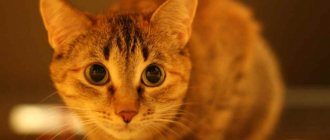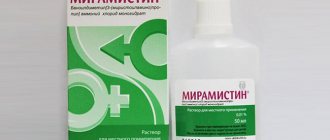Chemical composition and characteristics
Furosemide is a diuretic, which means it helps remove urine from the animal’s body. The drug blocks the absorption of sodium and chlorine ions, which retain fluid in the body. As a result, water is excreted along with potassium, calcium and magnesium ions.
According to the degree of impact on the animal’s body, the product belongs to the class of moderately hazardous substances (class 3). In addition to the main active ingredient of the same name, Furosemide contains components that help the medicine to be better absorbed. They are listed below in the table.
| Tablet | Solution |
| povidone | sodium metabisulfide |
| lactose | sodium hydroxide |
| MCC | water for injections |
| gelatin | methyl parahydroxybenzoate |
| potato starch | propyl parahydroxybenzoate |
| colloidal silicon dioxide | |
| magnesium stearate | |
| talc |
Reviews from pet owners about Furosemide
In general, reviews from dog and cat owners about Furosemide are positive. Pet owners note the reasonable cost of the product and the quick therapeutic effect. At the same time, undesirable reactions of the body are quite often observed in animals, especially disorders of the gastrointestinal tract and allergic reactions. In rare cases, owners of cats and dogs note the ineffectiveness of Furosemide and severe side effects that required immediate medical intervention. Accordingly, it can be called an effective medicine that is well worth its cost and is suitable for treating pets.
Furosemide is positively characterized by veterinarians and animal owners
Furosemide is an effective and affordable diuretic that is good for various diseases in dogs and cats. At the same time, do not forget that it is a powerful drug, so you should consult a veterinarian before use, and then carefully follow his recommendations.
Description of release form
Furosemide is available in tablet form and as a solution for injection.
Important! Self-treatment of your pet with Furosemide can lead to negative consequences. The drug should be given only after examination and prescription by a veterinarian.
Pills
The tablets are produced white, round, flattened. Packed in 10 or 25 pieces. Each individual unit contains 40 mg of the active ingredient (furosemide).
Solution
A 5% solution for intramuscular and intravenous injections is a clear liquid from colorless to light yellow. Available in dark glass bottles of 50 or 100 ml. The containers are tightly closed with rubber stoppers and secured with aluminum caps on top. 1 ml of the drug contains 50 mg of active substance.
Prevention of urolithiasis
After the cat’s treatment is completed, it is necessary to adhere to the rules of prevention for the rest of its life. It also doesn’t hurt to remember these measures if your pet is prone to urolithiasis. Prevention consists of proper selection of dietary food, drinking regimen, medications and folk remedies.
global $ads_google; //data-ad-slot=”2475549904″ $ads_google = empty($ads_google) ? false : true; ?> if ($ads_google == false) {?>
$ads_google = true; ?> } ?>
Food for the prevention of urolithiasis
The cat's nutrition should be organized taking into account the nature of the stones. Your cat should be fed premium ready-made food. The varieties that were used in treatment are also suitable for prevention. The same goes for a natural diet. Products that, during metabolism, acidify or, conversely, alkalize urine, are excluded from the diet. In any case, the cat's menu should not contain strong meat broths, sausages, fatty and salty foods. Food should be varied and nutritious.
Your pet should always have fresh water of low mineralization.
Medications
Many medications that are used to treat urolithiasis are also used for prevention. For this purpose, it is advisable to select products with natural composition. The best option is to consult a doctor. Preventive veterinary medications for urolithiasis include Kotervin, Urinari tract support, Furinite, Cantharis composite.
Kotervin removes salts, promotes better urine flow, relieves inflammation, dissolves stones (with the exception of oxalates). It contains only natural ingredients: extracts of horsetail, steelhead, knotweed and bird's eye.
Urinari tract support is a complex veterinary preparation based on bearberry, phylanthus, cranberry, marshmallow, dandelion, and corn silk. In addition to the salt-removing, diuretic and anti-inflammatory effects, Urinari has a mild immunomodulatory effect.
Folk remedies
The collection of traditional medicine offers many recipes that help improve the health of a cat that has had or is prone to urolithiasis. They are not potent drugs, but provide preventive support.
In the morning on an empty stomach, it is recommended to give the cat strawberry or carrot juice (1 teaspoon each). An infusion of lavender, birch, currant, hops, chamomile, plantain, horsetail and rosehip is also useful for oral administration. Herbs and fruits are taken in 5 grams each, then 5 grams of the collection is poured into 500 ml of boiling water. The pet is given 10 ml 2-3 times a day for a month.
When bathing, you can use a herbal bath, which is prepared from a collection of herbs (chamomile, dried grass, birch, oregano, sage, linden). For 500 ml of boiling water, take 1 gram of each type of plant material. The infusion is poured into a basin where the cat will bathe.
Indications for use of the drug
Furosemide is prescribed to cats when they develop swelling caused by the following reasons:
- severe form of hypertension;
- cirrhosis of the liver;
- with edema of the lungs, heart, brain;
- accumulation of fluid in the abdominal cavity due to liver disease;
- chronic heart failure;
- abnormal kidney function;
- intoxication or poisoning.
Furosemide is given to cats for severe hypertension
How much do the tablets cost and how much can you buy Furosemide solution for?
The price of Furosemide in injection form in Ukraine is from 14 UAH. The price of Furosemide in tablets is from 5.5 UAH.
The price of Furosemide diuretic tablets in Russian pharmacies is from 15 rubles. The price of ampoules is from 22.5 rubles.
- Online pharmacies in RussiaRussia
- Online pharmacies in UkraineUkraine
- Online pharmacies in KazakhstanKazakhstan
WER.RU
- Furosemide tablets 40 mg 50 pcs. Borisov Medical Preparations Plant 19 rub. order
- Furosemide tablets 40 mg 50 pcs. Irbit Chemical-Pharmaceutical Plant 22 RUR order
- Furosemide injection solution 20 mg/2 ml 2 ml 10 pcs. Borisov Medical Preparations Plant 22 rub. order
- Furosemide tablets 40 mg 20 pcs. Sopharma 22 rub. order
Europharm* 4% discount using promo code medside11
- Furosemide 40 mg 50 tabOZON, LLC 19.2 rub. order
- Furosemide 40 mg 20 tablets Sopharma JSC RUB 21.7 order
- Furosemide solution for injection 1% 2 ml 10 ampDHF JSC RUB 19.9 order
Pharmacy Dialogue* discount 100 rub. using promo code medside (for orders over 1000 rubles)
- Furosemide (40 mg tablet No. 50) 22 rub. order
- Furosemide (40 mg tablet No. 50) 30 rub. order
- Furosemide ampoules 1% 2ml No. 10 21 rub. order
- Furosemide tablets 40 mg No. 50 21 rub. order
Pharmacy IFC
- Furosemide SopharmaSopharma JSC, Bulgaria RUB 23.90 order
show more
Pharmacy24
- Furosemide-Darnitsa 1% 2 ml No. 10 solution for injection PrAT" Pharmaceutical company "Darnitsa", Ukraine 18.7 UAH. order
- Furosemide-Darnitsa 0.04 No. 50 tablets PrAT" Pharmaceutical company "Darnitsa", Ukraine 7.6 UAH. order
- Furosemide 4 mg No. 50 tablets PAT "Kievmedpreparat", Ukraine 13.05 UAH.order
- Furosemide 40 mg No. 20 tablets AT "Sopharma", Bulgaria 13.15 UAH. order
- Furosemide 40 mg No. 50 tablets PAT NEC "Borshchagivsky HFZ", m.Kiev/TOV "Agrofarm", Kiev region. 6.85 UAH.order
PaniPharmacy
- Furosemide tablets Furosemide tablets 40 mg No. 50 Ukraine, OZ GNCLS LLC 9.02 UAH.order
- Furosemide tablets Furosemide tablets. 40 mg No. 20 Bulgaria, Sopharma 14.02 UAH. order
- Furosemide ampoule Furosemide solution d/in. 1% amp. 2ml No. 10 Ukraine, Darnitsa ChAO 21.51 UAH. order
- Furosemide tablets Furosemide tablets 0.04g No. 50 Ukraine, Kievmedpreparat OJSC 14.55 UAH.order
- Furosemide tablets Furosemide tablets 40 mg No. 50 Ukraine, Darnitsa ChAO 8.71 UAH.order
show more
BIOSPHERE
- Furosemide 40 mg No. 50 tab. blister Borisovsky ZMP (Belarus) 190 tenge. order
- Furosemide 1%/2 ml No. 10 solution for intravenous amp. Borisovsky ZMP (Belarus) 250 tenge. order
show more
Instructions for use and dosage in veterinary medicine
The required dose of the drug is prescribed by the veterinarian, based on how much the animal weighs, what disease it has and how severe its condition is. The average dose of the drug per day is 5-6 mg per 1 kg of body weight in tablet form. In the form of injections - 0.5–0.6 ml per 10 kg of weight. But if necessary, the dosage can be doubled. The medicine should be given 30–40 minutes before meals.
Important! Complete analogues of "Furosemide" are drugs
"
Lasix
"
and
"
Salix
"
, which can be replaced with each other.
How to give Furosemide to a cat?
Furosemide from Latin, Furosemidum, is a fast-acting diuretic (diuretic), which contains the active ingredient of the same name.
Widely used in veterinary medicine for cattle, farm animals, as well as cats and dogs. Depending on the degree of the disease, different dosages are used for treatment. Furosemide for cats and dogs is prescribed by a veterinarian based on body weight.
They usually start with intramuscular injections, and when the necessary results are achieved, they switch to taking pills until complete recovery.
Release form
Furosemide is available in the following packaging::
- Injection solution - ampoules of 2 ml. There are 10 mg of active substance per 1 ml.
- Tablets - 1 tablet contains 40 mg of active ingredient.
© shutterstock
Indications for use
Furosemide causes dilation of the veins, thereby reducing the filling pressure of the left ventricle of the heart, as well as the pulmonary artery. Veterinarians identify the following diseases for which Furosemide is used :
- Swelling of the kidneys, heart and brain.
- Chronic and acute renal failure.
- Liver diseases, including cirrhosis.
- High blood pressure.
- Heart failure.
- For intoxication and poisoning.
- For all diseases that cause swelling.
Dosage and method of administration
It is used orally and intramuscularly. Furosemide is prescribed to a cat by a veterinarian after examining the cat. Furosemide is mainly used in the following dosages :
- Intramuscular or intravenous (5% solution) - Furosemide injections for cats are given at the rate of 0.1 ml per 1 kg of body weight. Administer 1-2 times a day depending on the degree of the disease.
- Orally - The daily dose for oral administration is 5-6 mg per 1 kg of cat weight. Give by mouth, diluted with water, strictly before meals.
Note. If necessary, the dose may be increased as prescribed by the doctor. The maximum course of treatment is 10 days. With prolonged use, adverse effects are possible. If during this time Furosemide does not help, then it is changed to another drug. During treatment, the cat needs increased attention and proper care.
Duration of action of Furosemide
In case of edema, Furosemide will cure a cat quickly, but only if all the doctor’s instructions are followed. Depending on the method of application, the speed of action of the medicine varies. When taking the tablet, the onset of action is within 15-30 minutes, and the effect lasts 6-8 hours.
When administered intramuscularly, the effect begins within 5-10 minutes, and the result is observed within 1.5-2 hours. Injections work much faster than tablets, but only a doctor determines what type of procedure a cat needs.
© shutterstock
Precautions and application features
When using Furosemide, you should pay attention to the following features::
- To achieve the desired therapeutic result, it is not recommended to skip regular doses of Furosemide.
- Do not use together with cephalosporin antibiotics, heart medications and Gentamicin.
- Mixing with other drugs in the same syringe is prohibited.
Use with caution
There are situations when it is necessary to use the drug in limited quantities. But only if the benefit outweighs the risk. Let's consider in what cases Furosemide is prescribed on a limited basis :
- Take with caution during pregnancy, with constant monitoring of the fetus.
- If there is a violation of the outflow of urine.
- Used in small doses for pancreatitis, diabetes and diarrhea.
- In case of low blood pressure and anemia.
Contraindications
The main guide to restrictions is the instructions for use of Furosemide. The same contraindications are provided for cats and cats as for people :
- Lactation period. Furosemide can pass through the cat's milk to the kittens, and may also reduce milk production.
- Liver failure with anuria.
- Urolithiasis disease.
- Individual intolerance to components.
- Reduced potassium levels in the blood.
- Violation of water-salt metabolism.
- Violation of acid-base balance.
- Acute glomerulonephritis (kidney disease).
- Hypertrophic cardiomyopathy.
© shutterstock
Side effects
In some cases, the following reactions are possible:
- General weakness and nausea.
- Disorder of the gastrointestinal tract.
- In cats, imbalance and other vestibular phenomena are possible.
It is important to understand that if any of the side effects occur, you should stop taking Furosemide and consult a veterinarian. These reactions may mean that the drug is not suitable for the cat, and its use may lead to undesirable results and worsen the course of the disease.
Source: https://KoshkaMurka.ru/8939-kak-davat-furosemid-koshke.html
Precautions and application features
When working with Furosemide, you should adhere to certain precautions and take into account the particularities of use, which include the following:
- the course of taking the drug should not exceed 10 days;
- It is not recommended to give to cats during pregnancy (only in case of emergency it is allowed in the 3rd trimester) or feeding;
- it is necessary to strictly adhere to the treatment regimen and not skip medication, as this may reduce the therapeutic effect;
- It is not advisable to give Furosemide simultaneously with other medications;
- Do not use the medicine after the expiration date;
- When working with an injection drug, you must adhere to the rules of personal hygiene (carefully wash your hands and face with soap), use rubber gloves;
- destroy used bottles without using them for other purposes.
Did you know? Residents of Great Britain and Australia believe that black cats bring only good luck.
Storage conditions and shelf life
The shelf life of furosemide is 2 years.
The storage conditions for the drug are subject to standard requirements:
- temperature regime of the liquid form of release - 5-25 degrees (closed bottle), 2-8 degrees (after opening the bottle);
- dark place;
- lack of open access for children and animals.
Furosemide retains its pharmacological properties for two years, taking into account the date of production of the product. After opening the bottle, the period is reduced to 28 days.
The shelf life of the tablet drug is 2 years.
Contraindications and side effects
Side effects from the medicine occur as a result of exceeding the required doses or violating the dosage regimen. As a result, the animal may experience:
- thirst;
- lethargy or agitation;
- vomiting or diarrhea;
- loss of appetite;
- hearing loss;
- tilting the head to the side;
- dehydration;
- rapid pulse;
- limb spasms.
Side effects include decreased appetite.
The drug is contraindicated in the following cases:
- liver failure;
- renal failure;
- urolithiasis disease;
- myocardial infarction, narrowing of the aorta or mitral valve;
- violation of water-salt metabolism or acid-base balance;
- low potassium levels in the blood;
- allergy to one of the components of the drug.
Learn about common cat diseases and how to treat them.
Diagnosis: how to understand that your pet has ICD?
Only a veterinarian can determine that a cat has urolithiasis. There are a number of techniques for this:
- palpating with fingers;
- laboratory urine test;
- radiography;
- Ultrasound;
- radiography with contrast.
Important! Sometimes, to determine ICD in cats at home, owners use a folk method: leave a jar of pet urine for an hour, and then look at the sediment. This method is absolutely incorrect. The formation of sediment is a consequence of natural processes that do not indicate the presence of pathology.
Price and analogues
The cost of Furosemide differs depending on the dosage form. So a bottle (50 ml) of a 5% solution costs 14.70 rubles, and tablets (50 pcs.) cost from 26 to 32 rubles. If necessary, the drug can be replaced with similar drugs, such as:
- "Torasemide" - has a long-term effect (up to 18 hours), but can lower blood pressure;
- "Indapamide" - relieves swelling well and is inexpensive, but less effective than "Furosemide";
- “Amiloride” is gentle and long-lasting (24 hours), but it is necessary to regulate the level of potassium in the blood;
- "Triamterene" - practically does not cause side effects, but is poorly soluble in water;
- “Hypothiazide” is a potent substance that does not interfere with the functioning of the kidneys and liver, but is available only in the form of a solution;
- “Veroshpiron” is well absorbed into the blood, does not wash away potassium, but can lead to its excess.
It is necessary to replace one medication with another only after examination by a veterinarian
special instructions
To achieve the required therapeutic effect, you must strictly follow the dosage and the veterinarian's instructions. Injections of the drug are made in the usual way, but the solution cannot be mixed with other drugs in the same syringe. Furosemide can be used in combination with other medications, with the exception of cephalosporin antibiotics, heart medications and Gentamicin.
You cannot mix the solution with other products in the same syringe.
Cats and dogs treated with MI require monitoring of kidney function and monitoring of the concentration of sodium, potassium and other minerals in the body, as they are flushed out along with excess fluid.
With long-term use, the drug can cause changes in blood composition and other serious pathologies, so long-term treatment is best avoided. If the drug does not provide the required therapeutic effect, you should contact your veterinarian and replace it with another one.
In case of renal failure in cats and dogs, Furosemide has a more symptomatic than therapeutic effect, so it is impossible to treat the disease exclusively with diuretics - it is necessary to find its cause and apply an integrated approach.
When using the drug, you must strictly follow medical recommendations.
The shelf life of Furosemide is 2 years; after opening the bottle of solution, it is reduced to 28 days. The drug should be stored at a temperature not exceeding 25 degrees in a dark place, protected from children and animals. An open bottle of solution should be kept in the refrigerator at a temperature of 2-8 degrees.











